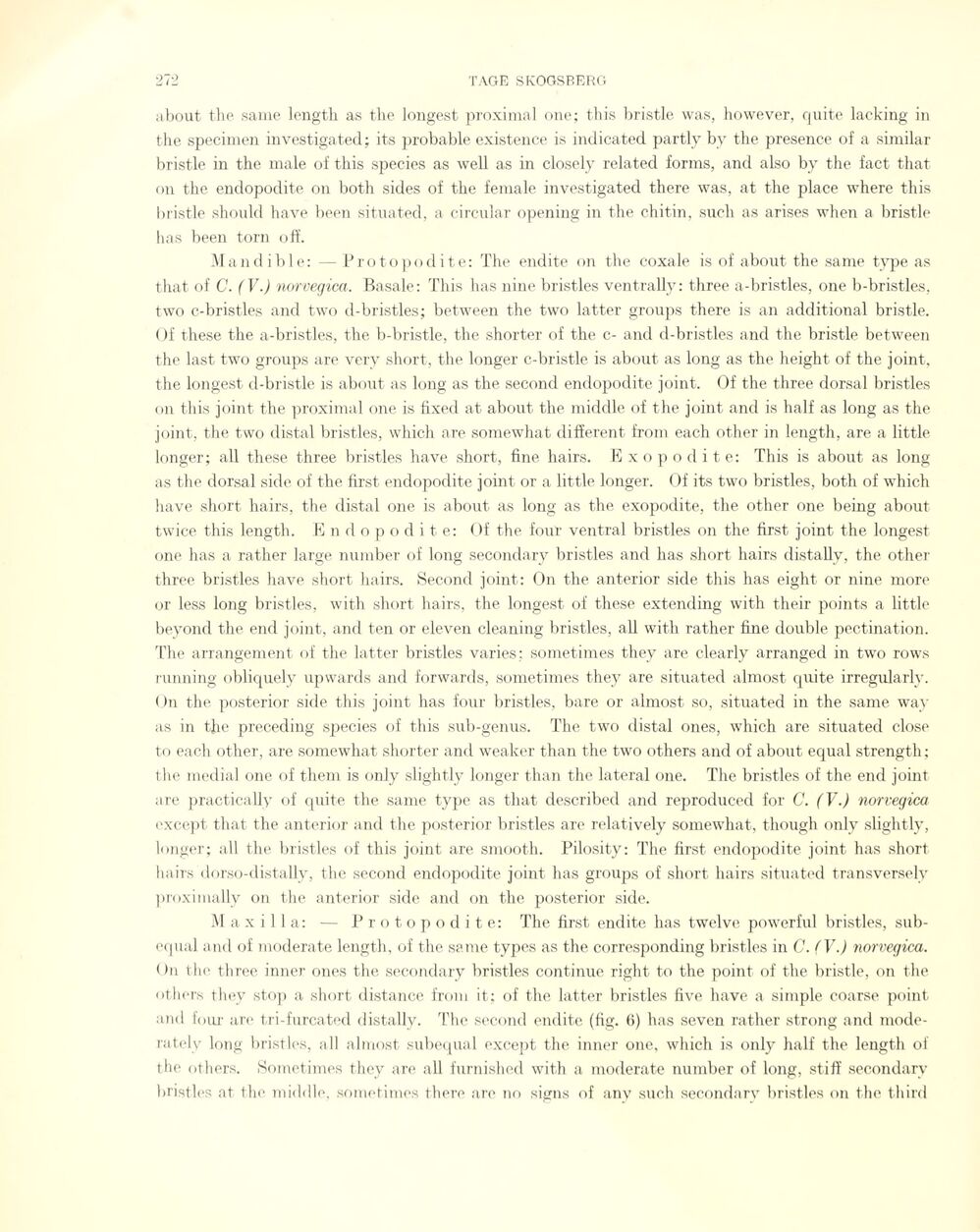
Full resolution (JPEG) - On this page / på denna sida - Sidor ...

<< prev. page << föreg. sida << >> nästa sida >> next page >>
Below is the raw OCR text
from the above scanned image.
Do you see an error? Proofread the page now!
Här nedan syns maskintolkade texten från faksimilbilden ovan.
Ser du något fel? Korrekturläs sidan nu!
This page has never been proofread. / Denna sida har aldrig korrekturlästs.
about tbe same lengtk as the longest proximal one; this bristle was, however, quite lacking in
the specimen investigated; its probable existence is indicated partly by tlie presence of a similar
bristle in the male of this species as well as in closely related forms, and also by the faet that
on the endopodite on both sides of the female investigated there was, at the place where this
bristle should have been situated, a circular opening in the chitin, such as arises when a bristle
has been torn o ff.
M a n d i b 1 e : — Protopodite: The endite on the coxale is of about the same type as
that of C. (V.) norvegica. Basale: This has nine bristles ven trally: three a-bristles, one b-bristles,
two c-bristles and two d-bristles; between the two latter groups there is an additional bristle.
Of these the a-bristles, the b-bristle, the shorter of the c- and d-bristles and the bristle between
the last two groups are very short, the longer c-bristle is about as long as the height of the joint,
the longest d-bristle is about as long as the second endopodite joint. Of the three dorsal bristles
on this joint the proximal one is fixed at about the middle of the joint and is half as long as the
joint, the two distal bristles, wkich are somewhat different from each other in length, are a little
longer ; all these three bristles have short, fine hairs. Exopodite: This is about as long
as the dorsal side of the first endopodite joint or a little longer. Of its two bristles, both of which
have short hairs, the distal one is about as long as the exopodite, the other one being about
twice this length. Endopodite: Of the four ventral bristles on the first joint the longest
one has a rather large number of long secondary bristles and has short hairs distally, the other
three bristles have short hairs. Second joint: On the anterior side this has eight or nine more
or less long bristles, with short hairs, the longest of these extending with their points a little
beyond the end joint, and ten or eleven cleaning bristles, all with rather fine double pectination.
The arrangement of the latter bristles varies: sometimes they are clearly arranged in two rows
running obliquely upwards and forwards, sometimes they are situated almost quite irregularly.
On the posterior side this joint has four bristles, bare or almost so, situated in the same way
as in the preceding species of this sub-genus. The two distal ones, which are situated close
to each other, are somewhat shorter and weaker than the two others and of about equal strength ;
the medial one of them is only slightly longer than the lateral one. The bristles of the end joint
are practically of quite the same type as that described and reproduced for C. ( V.) norvegica
except that the anterior and the posterior bristles are relatively somewhat, though only slightly,
longer; all the bristles of this joint are smooth. Pilosity: The first endopodite joint has short
hairs dorso-distally, the second endopodite joint has groups of short hairs situated transverselv
proximally on the anterior side and on the posterior side.
Maxilla: — Protopodite: The first endite has twelve powerful bristles, sub-
equal and of moderate length, of the same types as the corresponding bristles in C. (V.) norvegica.
On the three inner ones the secondary bristles continue right to the point of the bristle, on the
others they stop a short distance from it; of the latter bristles five have a simple coarse point
and four are tri-furcated distally. The second endite (fig. 6) has seven rather strong and
moderately long bristles, all almost subequal except the inner one, which is only half the length of
the others. Sometimes they are all furnished with a moderate number of long, stiff secondary
bristles at the middle, sometimes there are no signs of any such secondary bristles on the third
<< prev. page << föreg. sida << >> nästa sida >> next page >>